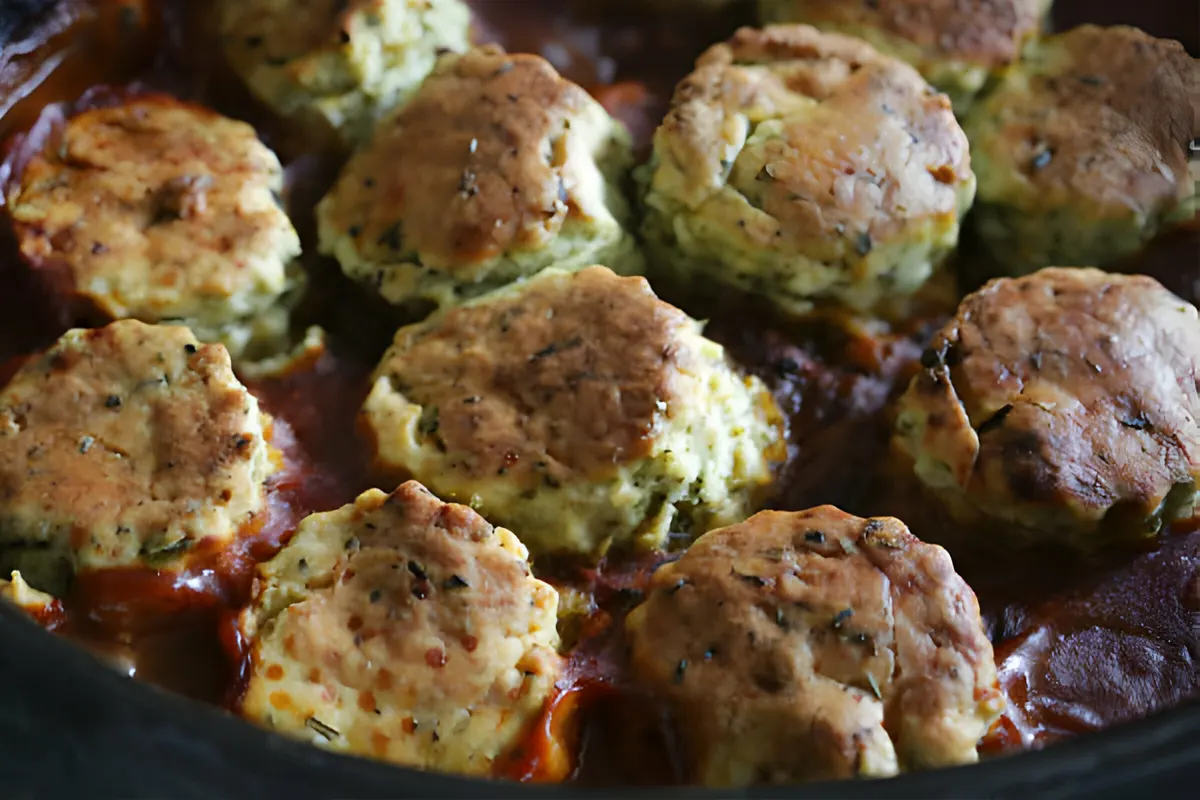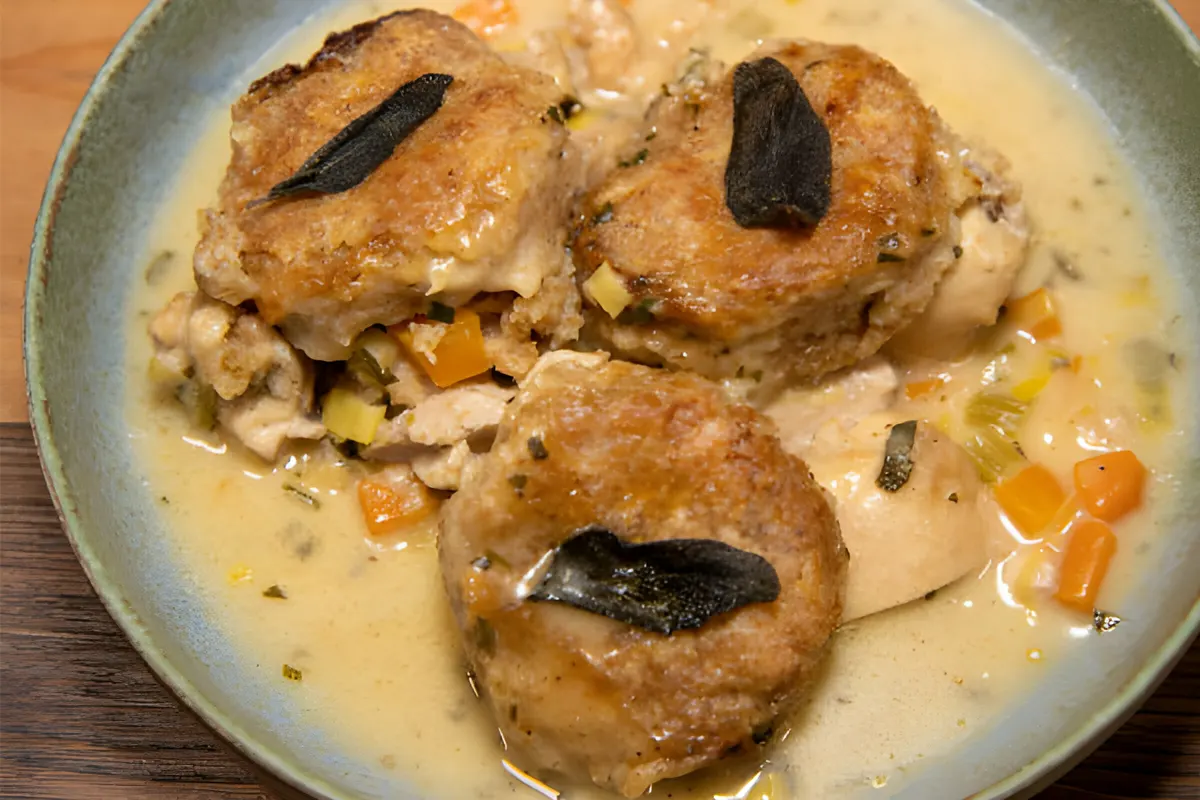Introduction to Chicken Cobbler: A Comfort Food Classic
Overview of Chicken Cobbler
Chicken Cobbler is more than just a dish; it’s a comforting embrace on your dining table. This culinary delight combines succulent chicken, vibrant vegetables, and a luscious golden biscuit crust, embodying the essence of homestyle cooking. Simple yet sophisticated, Chicken Cobbler is a testament to the culinary magic of combining basic ingredients with a touch of love and culinary finesse.
Popularity and Origins
Tracing its roots back to traditional sweet fruit desserts, Chicken Cobbler has evolved into a savory sensation, gaining immense popularity across the United States. Originating from the Southern kitchen, this savory twist on the classic dessert has become a beloved staple in households nationwide, cherished for its heartwarming qualities and delicious taste.
Why It’s a Family Favorite
Chicken Cobbler’s allure lies in its perfect marriage of convenience and delectable flavor. It’s an all-in-one dish that’s effortlessly prepared, making it a go-to recipe for busy weeknights. Its versatility in ingredients caters to various dietary needs and preferences, while the combination of a creamy, savory filling and a fluffy, buttery biscuit crust appeals to all age groups, transforming dinner into a delightful culinary event.
Stay tuned as we explore the essential ingredients and creative substitutions that make Chicken Cobbler a versatile and inclusive dish for everyone.
Essential Ingredients and Substitutions: Crafting the Perfect Chicken Cobbler
Key Ingredients for Chicken Cobbler
At the heart of a scrumptious Chicken Cobbler are its core ingredients. Essential components include cooked chicken (roasted, boiled, or leftover rotisserie for convenience), frozen mixed vegetables for a nutritious and colorful addition, and a biscuit mix for that irresistible topping. The creamy elements, such as milk and chicken broth, bind these ingredients into a harmonious blend of flavors.
Substitutes for Common Allergens and Dietary Restrictions
No one should miss out on the joy of Chicken Cobbler due to dietary restrictions. For a gluten-free version, opt for gluten-free biscuit mix and thickeners. Those who are lactose intolerant can use lactose-free milk and butter substitutes. Vegetarians can enjoy this dish too, by substituting chicken with robust vegetables like cauliflower or plant-based meat alternatives, and using vegetable broth in place of chicken broth.
Creative Ingredient Variations
The adaptability of Chicken Cobbler allows for endless culinary creativity. Add a kick with cayenne pepper, or infuse aromatic herbs like thyme or rosemary for a fragrant twist. Cheese enthusiasts can incorporate cheddar or parmesan for an extra cheesy flavor. For a unique texture, consider a topping of crushed crackers mixed with melted butter before baking.
Next, we’ll guide you through the step-by-step process of preparing this delightful dish, ensuring your Chicken Cobbler is baked to perfection.
Step-by-Step Cooking Instructions: Mastering Chicken Cobbler

Preparing the Chicken and Vegetables
Begin by preparing your chicken and vegetables. Shred leftover or rotisserie chicken into bite-sized pieces. Choose a mix of classic vegetables like carrots, peas, and corn, or get creative with your selection. If using frozen vegetables, there’s no need to thaw them, as they’ll cook perfectly within the cobbler.
Mixing and Assembling the Cobbler
Now comes the enjoyable part of assembling your Chicken Cobbler. In a large bowl, prepare the biscuit dough as per the package instructions. In your baking dish, layer the chicken and vegetables first, followed by an even spread of the biscuit mixture on top. Remember, don’t mix the layers; let them sit distinctly for a layered effect.
Baking Tips for Perfect Texture and Flavor
Preheat your oven to the appropriate temperature, typically around 375°F to 400°F. Bake the cobbler until the top turns golden brown and the filling is bubbly, which should take about 40-50 minutes. Allow the cobbler to rest for a few minutes after baking; this helps the sauce thicken and makes serving easier.
Next, we’ll explore the best ways to serve and pair your Chicken Cobbler, ensuring a complete and satisfying meal experience.
Serving and Pairing Suggestions: Complementing Your Chicken Cobbler
Ideal Side Dishes
While Chicken Cobbler can be a standalone dish, the right side dishes can elevate it to a culinary feast. Consider a light green salad with a zesty vinaigrette to balance the richness of the cobbler. For a more substantial side, garlic mashed potatoes or buttered green beans are excellent choices. A tangy coleslaw can add a refreshing crunch and zest to the meal.
Wine and Beverage Pairings
Selecting the perfect beverage can enhance your Chicken Cobbler experience. A light, crisp white wine like Chardonnay or Sauvignon Blanc pairs wonderfully with the creamy richness of the dish. Non-alcoholic options like recipestrip.com
sparkling apple cider or iced herbal tea offer a refreshing complement. For children, a glass of cold milk is a delightful match with the biscuit topping.
Next, we’ll delve into the nutritional aspects of Chicken Cobbler, providing insights for those mindful of their dietary intake.
Nutritional Information: Balancing Taste and Health
Caloric Content and Macronutrients
Understanding the nutritional content of Chicken Cobbler is key to maintaining a balanced diet. A typical serving offers a blend of proteins from the chicken, carbohydrates from the biscuit topping, and a moderate amount of fats, mainly from butter and milk. The vegetables contribute fiber and essential vitamins. On average, a serving ranges from 300 to 500 calories, varying with the ingredients used.
Making a Healthier Chicken Cobbler
For a healthier twist, use lean chicken breast to reduce fat content. Opt for whole wheat biscuit mix to increase fiber, and low-fat milk to cut down on calories without sacrificing the creamy texture. Incorporating more vegetables not only boosts nutritional value but also enhances the dish’s flavors and colors.
In the next section, we’ll address some frequently asked questions about Chicken Cobbler, providing expert answers to enhance your cooking experience.
FAQs: Expert Insights on Chicken Cobbler
Common Questions and Expert Answers
- Q: Can I make Chicken Cobbler ahead of time? A: Yes, assemble the cobbler and refrigerate it for up to a day before baking. Add extra baking time if starting from cold.
- Q: How can I thicken the cobbler filling? A: Use a cornstarch-water mixture for a runny filling, or let the cobbler sit after baking for natural thickening.
- Q: Can Chicken Cobbler be frozen? A: Freeze the cobbler before or after baking. Thaw overnight in the refrigerator and reheat in the oven.
- Q: How to make a vegetarian Chicken Cobbler? A: Use hearty vegetables or plant-based meat substitutes and vegetable broth instead of chicken and chicken broth.
- Q: Is a dairy-free Chicken Cobbler possible? A: Yes, use dairy-free milk, butter alternatives, and dairy-free biscuit mix.
Next, we’ll share advanced tips and tricks to elevate your Chicken Cobbler, ensuring every bite is as delicious as possible.
Advanced Tips and Tricks: Perfecting Chicken Cobbler
Time-Saving Techniques
For quick preparation, use pre-cooked and shredded chicken, like rotisserie chicken, and a ready-made biscuit mix. Frozen mixed vegetables are also a great time-saver.
Enhancing Flavors and Textures
Sauté vegetables with garlic and herbs before adding to the cobbler for enhanced flavor. A dash of white wine in the chicken mixture can add depth. Brush biscuits with melted butter or an egg wash before baking for a golden crust.
Storing and Reheating for Best Results
Chicken Cobbler keeps well in the refrigerator for 3-4 days. Reheat covered in the oven at a moderate temperature. For frozen cobbler, thaw overnight in the refrigerator before reheating.
For more information on safe food handling and storage, visit FoodSafety.gov.
In the next part, we’ll explore variations of the Chicken Cobbler recipe, offering alternative versions for different dietary needs and regional twists.
Variations of the Recipe: Adapting Chicken Cobbler
Alternative Versions for Dietary Needs
Gluten-free, low-carb, and dairy-free versions of Chicken Cobbler are easily achievable with appropriate substitutes like gluten-free biscuit mix, cauliflower mash topping, and plant-based milk and butter.
Regional Twists on Chicken Cobbler
Incorporate local ingredients for regional flavors. Add green chilies and cumin for a Southwest twist, or maple syrup to the biscuit mix for a Northeastern touch.
Seasonal Adaptations
Tailor your Chicken Cobbler to the seasons
by adding seasonal vegetables. In spring, include fresh asparagus or peas. During summer, zucchini and bell peppers add freshness. In fall, root vegetables like sweet potatoes bring a hearty flavor, and in winter, mushrooms and dark leafy greens offer a comforting touch.
Conclusion and Final Thoughts: Embracing Chicken Cobbler
Recap of Key Points
Throughout our exploration of Chicken Cobbler, we’ve delved into its rich history, key components, and culinary methods. Our journey included adapting the recipe to suit diverse dietary preferences, complementing it with suitable sides and beverages, and gaining insights into its nutritional profile. Additionally, we addressed frequently asked questions and offered expert advice for refining this beloved dish.
Encouragement to Try the Recipe
Chicken Cobbler is a versatile and forgiving dish, ideal for both experienced cooks and beginners. It’s perfect for family dinners, gatherings, or when you need a comforting meal. So, gather your ingredients, preheat your oven, and embark on a culinary adventure with Chicken Cobbler.

